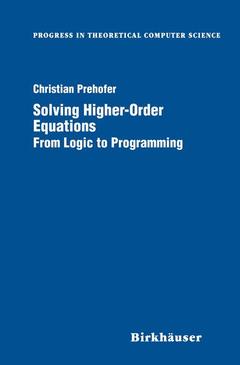Description
Solving Higher-Order Equations, 1998
From Logic to Programming
Progress in Theoretical Computer Science Series
Author: Prehofer Christian
Language: English
Subjects for Solving Higher-Order Equations:
Solving Higher-Order Equations
Publication date: 12-1997
188 p. · 15.5x23.5 cm · Hardback
Publication date: 12-1997
188 p. · 15.5x23.5 cm · Hardback
Approximative price 105.49 €
In Print (Delivery period: 15 days).
Add to cart
Solving Higher-Order Equations
Publication date: 10-2012
188 p. · 15.5x23.5 cm · Paperback
Publication date: 10-2012
188 p. · 15.5x23.5 cm · Paperback
Description
/li>Contents
/li>
This monograph develops techniques for equational reasoning in higher-order logic. Due to its expressiveness, higher-order logic is used for specification and verification of hardware, software, and mathematics. In these applica tions, higher-order logic provides the necessary level of abstraction for con cise and natural formulations. The main assets of higher-order logic are quan tification over functions or predicates and its abstraction mechanism. These allow one to represent quantification in formulas and other variable-binding constructs. In this book, we focus on equational logic as a fundamental and natural concept in computer science and mathematics. We present calculi for equa tional reasoning modulo higher-order equations presented as rewrite rules. This is followed by a systematic development from general equational rea soning towards effective calculi for declarative programming in higher-order logic and A-calculus. This aims at integrating and generalizing declarative programming models such as functional and logic programming. In these two prominent declarative computation models we can view a program as a logical theory and a computation as a deduction.
1 Introduction.- 2 Preview.- 2.1 Term Rewriting.- 2.2 Narrowing.- 2.3 Narrowing and Logic Programming.- 2.4 ?-Calculus and Higher-Order Logic.- 2.5 Higher-Order Term Rewriting.- 2.6 Higher-Order Unification.- 2.7 Decidability of Higher-Order Unification.- 2.8 Narrowing: The Higher-Order Case.- 3 Preliminaries.- 3.1 Abstract Reductions and Termination Orderings.- 3.2 Higher-Order Types and Terms.- 3.3 Positions in ?-Terms.- 3.4 Substitutions.- 3.5 Unification Theory.- 3.6 Higher-Order Patterns.- 4 Higher-Order Equational Reasoning.- 4.1 Higher-Order Unification by Transformation.- 4.2 Unification of Higher-Order Patterns.- 4.3 Higher-Order Term Rewriting.- 5 Decidability of Higher-Order Unification.- 5.1 Elimination Problems.- 5.2 Unification of Second-Order with Linear Terms.- 5.3 Relaxing the Linearity Restrictions.- 5.4 Applications and Open Problems.- 6 Higher-Order Lazy Narrowing.- 6.1 Lazy Narrowing.- 6.2 Lazy Narrowing with Terminating Rules.- 6.3 Lazy Narrowing with Left-Linear Rules.- 6.4 Narrowing with Normal Conditional Rules.- 6.5 Scope and Completeness of Narrowing.- 7 Variations of Higher-Order Narrowing.- 7.1 A General Notion of Higher-Order Narrowing.- 7.2 Narrowing on Patterns with Pattern Rules.- 7.3 Narrowing Beyond Patterns.- 7.4 Narrowing on Patterns with Constraints.- 8 Applications of Higher-Order Narrowing.- 8.1 Functional-Logic Programming.- 8.2 Equational Reasoning by Narrowing.- 9 Concluding Remarks.- 9.1 Related Work.- 9.2 Further Work.
© 2024 LAVOISIER S.A.S.




